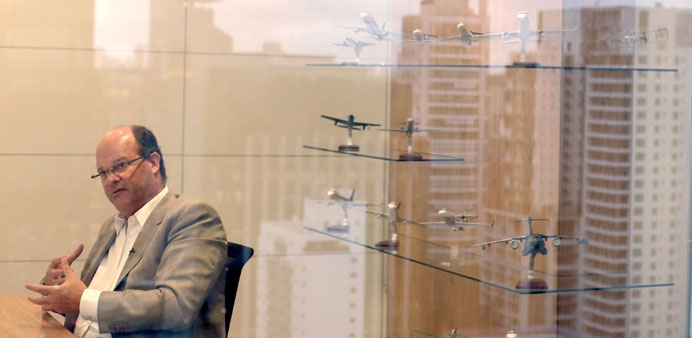Foreign direct investment has averaged about $5bn a month this year, more than double the levels seen in 2010
Reuters/Sao Paulo
Just two years ago, Brazil was still hailed as “The Near China” — an economy that offered East Asia-style 7% growth rates in a seductive, sun-kissed package that was closer to home for Western investors.
Today, the thrill is gone.
Economic growth limped in at less than 1% last year, 2013 is looking pretty mediocre, and words like “facade” and “bubble” are being used to describe Brazil by some in the international press.
Nevertheless, speakers at this week’s Reuters Latin America Investment Summit said they still see plenty of opportunities in the region’s largest economy.
While it’s not the free-for-all of years past, money is still there for the taking in sectors such as infrastructure, technology and education, some of which are still behaving as if the boom years never ended, they said.
“It’s not as bad as some say now, and it was never as good as some said then,” said Fernando Henrique Cardoso, a former president from 1995 to 2002 who is now an opposition leader and one of Brazil’s most respected voices in business circles.
“There’s still a lot to be done,” he said, citing road and railway projects that seek to address terrible transportation bottlenecks. He also said there are still chances to invest in infrastructure as Brazil prepares to host the 2014 World Cup and 2016 Olympics.
To be sure, Cardoso and others are frustrated that Brazil isn’t living up to its previous hype. Gross domestic product is expected to grow around 3% this year, while inflation could close the year at 5.8%, according to economists’ average forecasts.
The stock market has fallen 8% this year, and about a fifth from its peak in 2008, as investors realized they hadn’t bought into an Asian tiger after all. Others have voiced frustration with leftist President Dilma Rousseff’s interventionist management of the economy.
But the lacklustre numbers have been leavened by others suggesting continued bets on a bright long-term future. Unemployment rose slightly in April but was still at 5.8%, its lowest level in at least a decade, as companies position themselves for a moderate recovery.
Foreign direct investment has averaged about $5bn a month this year, more than double the levels seen in 2010.
Rodrigo Galindo, CEO of Kroton Educacional, Brazil’s largest provider of undergraduate distance learning, said his business depends “much more” on unemployment levels than GDP growth, pointing to net revenue that grew by a quarter in 2012, even when the economy was flat.
Indeed, the greatest opportunities seem to lie in precisely the areas that have been holding Brazil’s economy back the most.
Take education: Many economists have blamed falling productivity for Brazil’s recent downshift in growth, and said better schools are a huge part of any medium-term solution.
Infrastructure, too, has been attractive because Brazil’s government knows the economy can’t grow much faster without massive private-sector investment in ports, airports and railroads that are overburdened after last decade’s boom.
The government’s “road shows” to promote some $66bn worth of building projects in coming years have played to mostly packed venues in Europe and the US. US diplomats in particular report a constant flux of business delegations to Brazil to look at opportunities.
“The market has been excited since the launch of the programme,” the government’s point man on infrastructure, Bernardo Figuereido, said at the summit.
Until those bottlenecks can be addressed, Galindo, of Kroton, called forecasts for 3% GDP growth this year “reasonable,” an opinion that was echoed by most others.
“I think it’s about as good as we can have right now,” said BlackRock’s Latin American fund manager Will Landers, who manages $6bn in regional stocks.
For those with long memories, such growth is actually pretty standard. Economic growth averaged 3.6% from 2003-12, the decade that saw Brazil shed its reputation as a perennial underperformer.
The key, most agreed, is that GDP actually reaches that 3% level, as opposed to another year like 2011 and 2012 in which analysts have to constantly cut their forecasts throughout the year. A big clue will come next Wednesday, when the government releases GDP data for the first quarter.
Frederico Curado, CEO of Embraer, the world’s biggest maker of regional jets, said he had “seen” forecasts for both 3% and 1.5% GDP growth for 2013, calling this a “delicate moment” for the economy.
One critical question is whether investors will grow more comfortable with Rousseff, who has tried to create a better business environment but has often done so in heavy-handed ways. For example, her plan to cut electricity rates last year also slashed the market valuations of power companies bybns of dollars.
Curado, like many Brazilian executives, delicately acknowledged there are misgivings about the government, but said its policies may yet bear fruit.
“Whether they’ve done it the right or the wrong way, I don’t have the technical expertise to give you an opinion,” Curado said. “But they’re all the right initiatives. In theory, we should be seeing the economy accelerate by now.”

